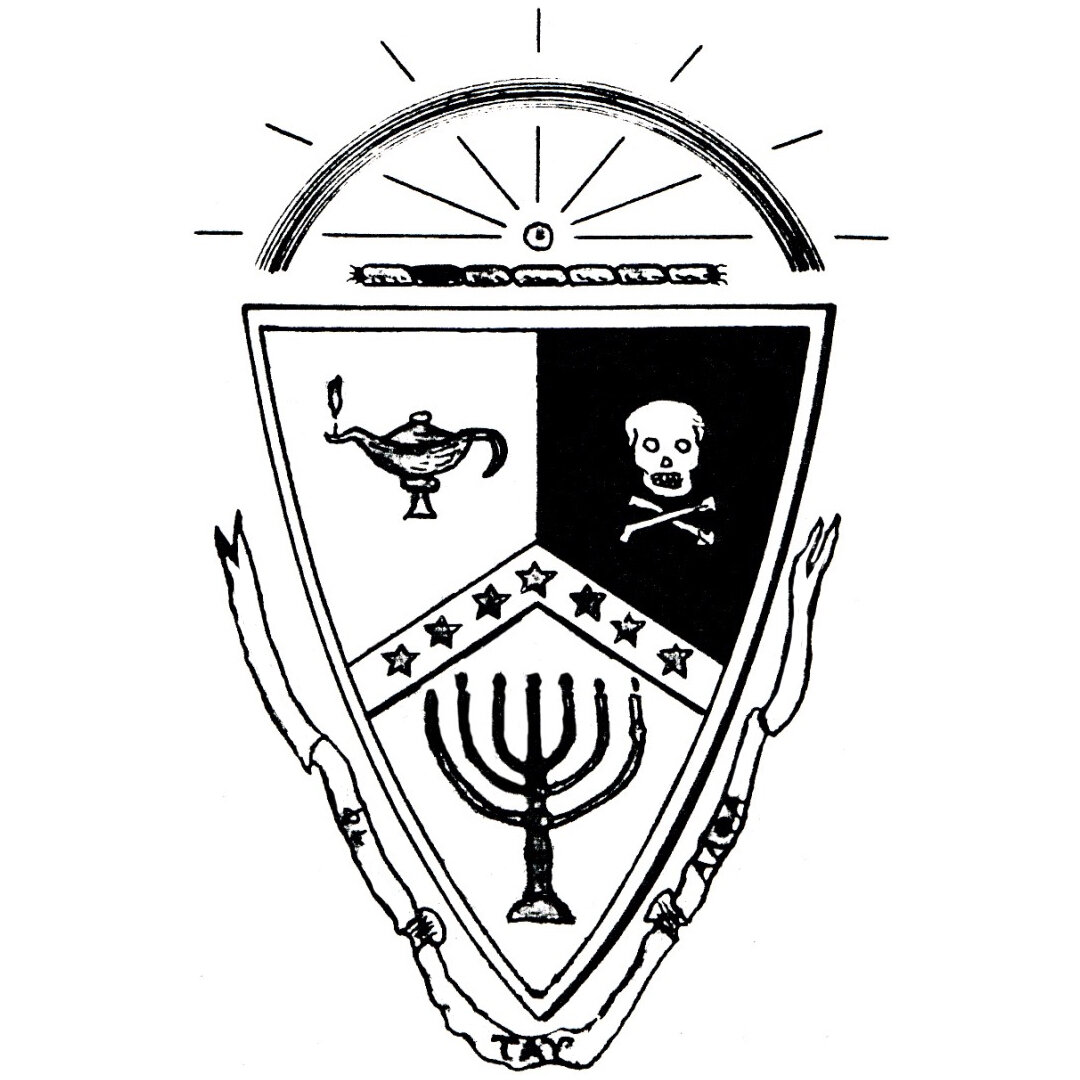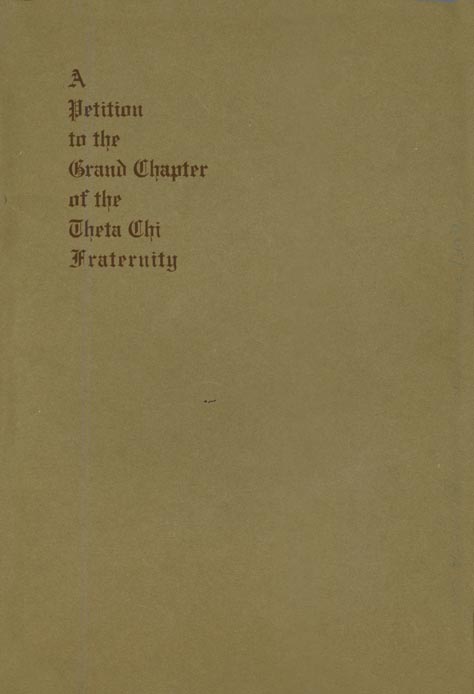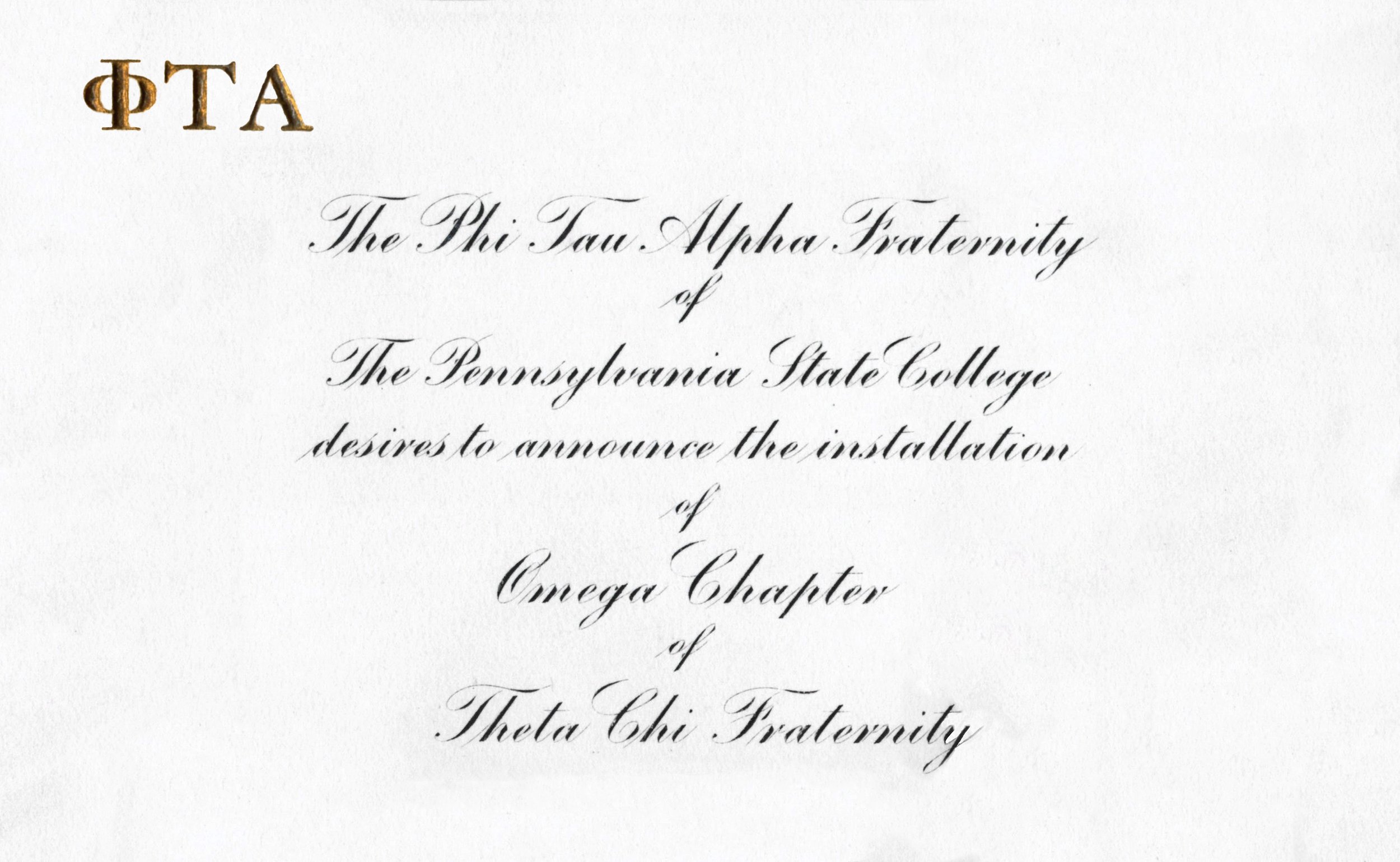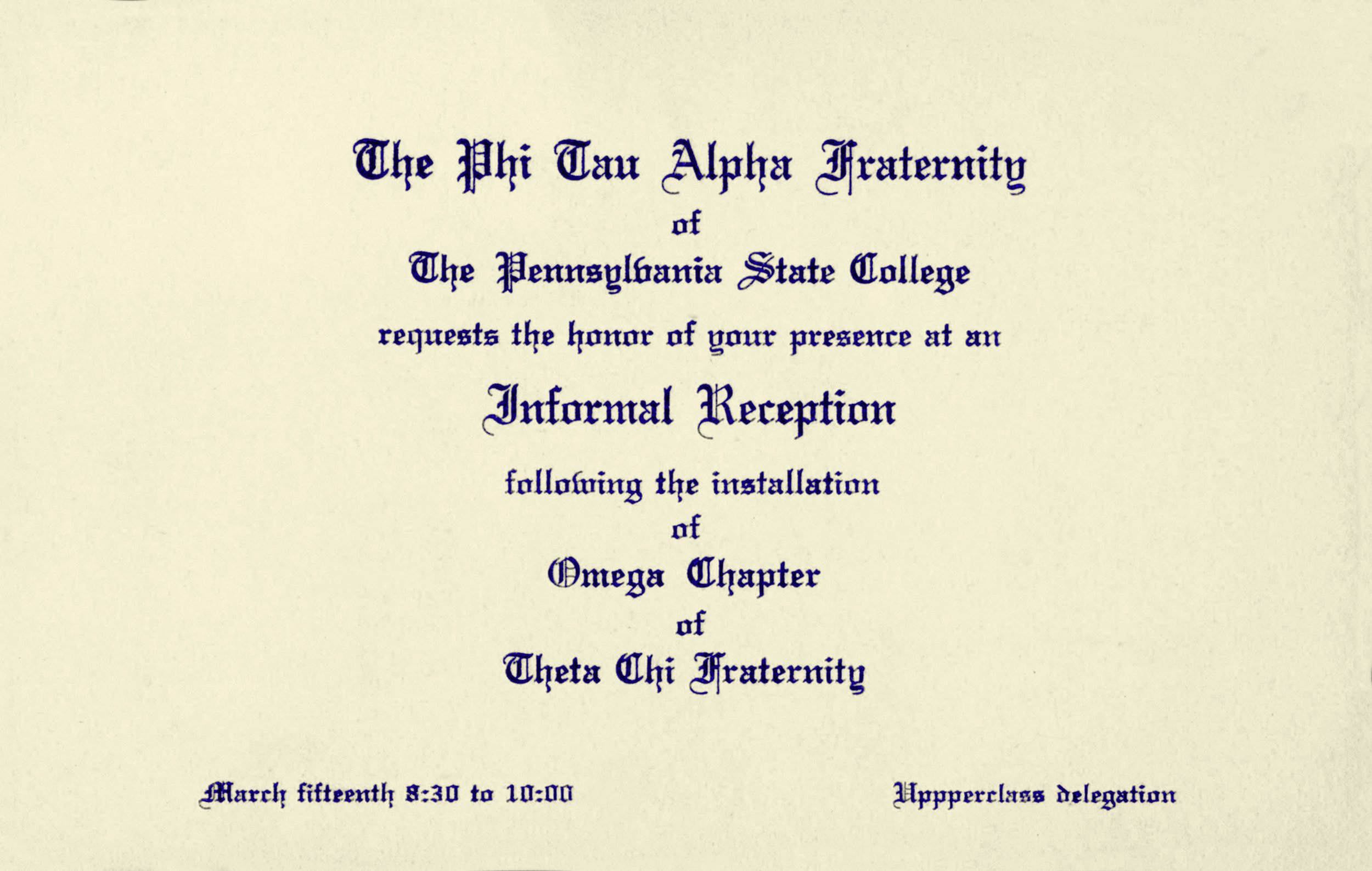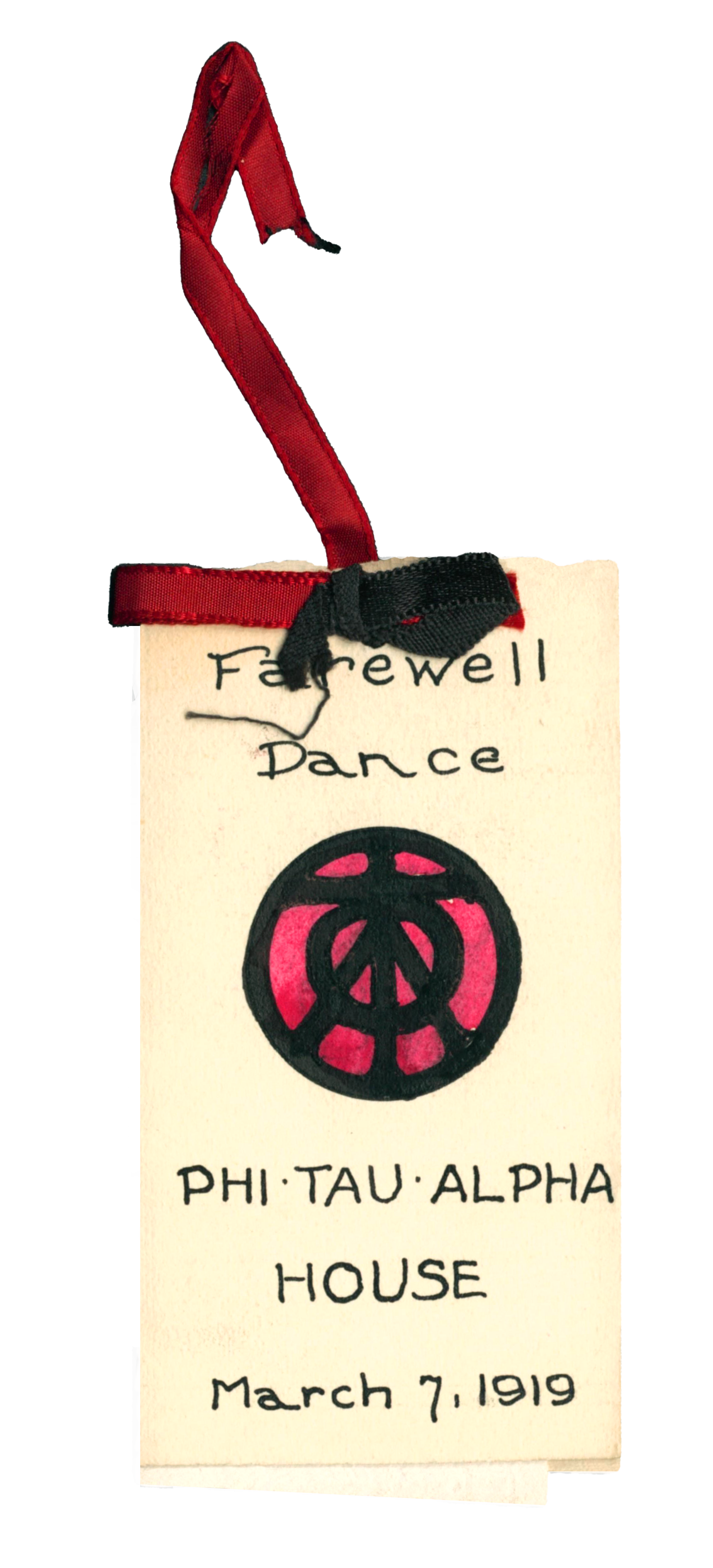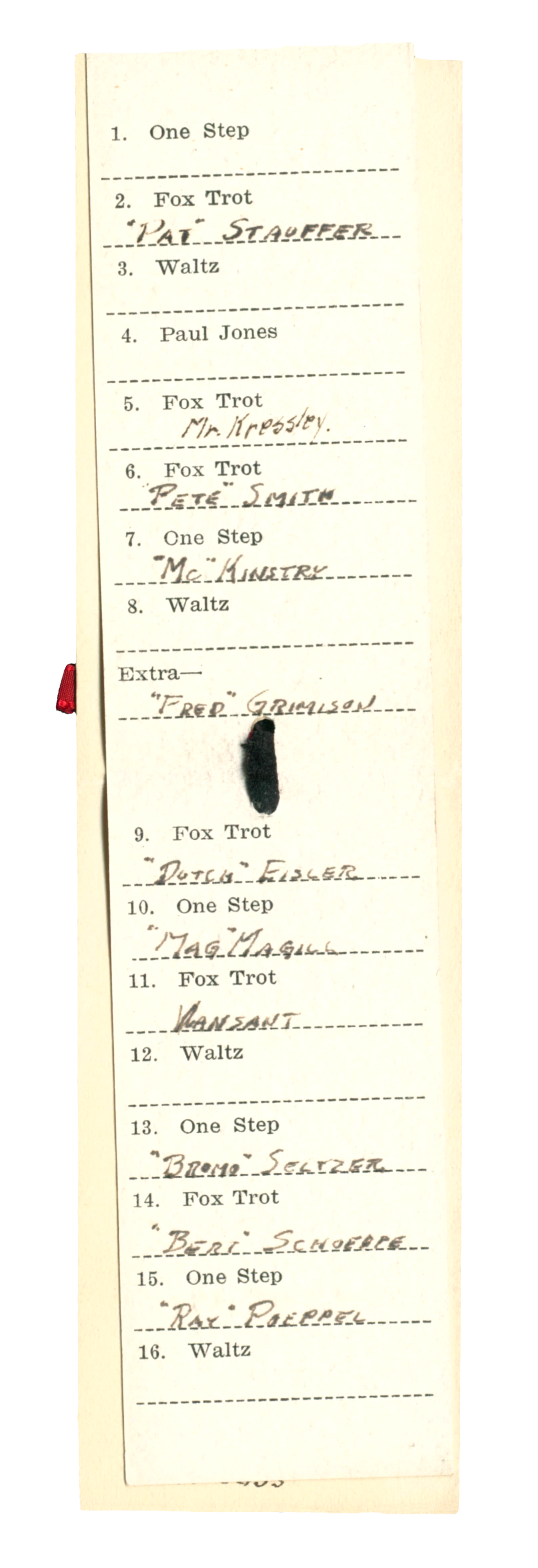Phi Tau Alpha Era
by Ellwood B. Cassel '19
As written for the January 1933 The Rattle - Vol. XXI, No. 4 (Part 1)
As written for the March 1933 The Rattle - Vol. XXI, No. 6 (Part 2)
During the early part of the school semester of 1917 and 1918, there were many heated, high-pitched and fiery meetings of the Northeast Club concerning the question as to weather that club, then a restricted local fraternity, should continue in that capacity or throw off its restrictions and become a local non-restrictive fraternity. The members for and against the change put every ounce of energy into swinging the decision to their respective opinions. After weeks of debate, which threatened the very existence of the war depleted membership, the vote was finally taken and the result was the establishment of the Phi Tau Alpha Fraternity. This was not accomplished without the loss of one or two members of the old Northeast Club who could not be convinced that making the change was the only logical course to pursue.
Events since that time have proved that the committee, which drew up the reasons for making the change, were farsighted and their conclusions entirely correct. The report of this committee is quoted in “The Story of the Northeast Club.”
After finally making the decision to become a local non-restrictive fraternity, which many members believed would be the most difficult thing to legislate through the firm-minded membership, it was found that the work had just begun and it was all uphill going.
The president, Winfield F. Smith '20, appointed committee to get facts and date and work up their recommendations on name, constitution, ritual, insignia, etc. It was the work of the members of these various committees that actually created the local fraternity of Phi Tau Alpha. Their work interwove and there were many joint meetings of the committees to create a name, constitution, ritual and insignia, which would dovetail into a workable organization. This task of revision and creation by the committees was difficult enough to attain in the committee membership, but to get their work successfully through the general meeting was another long discussion of opinions – opinions that were unbendingly obstinate on many points.
This work of creating a new organization vastly different from the Northeast Club was carried on in the mid-winter of 1917-1918. While it was being accomplished operations were continued under the laws of the existing club, gradually changing in the form of meetings and getting ready to operate smoothly under a new name, constitution and ritual. When the Fraternity Committee of the General Faculty of the College granted permission to make the change on February 23, 1915, the new organization was practically ready to function, but it was not until April 6, 1918 that the formal change was announced to the college and other fraternities by a smoker and reception.
Actual initiation of charter members of Phi Tau Alpha took place on March 22, 1918. On April 15, 1918 we were admitted to the Intramural Council, an organization of the local Greek Letter fraternities. This marked the final step in the official establishment of the Phi Tau Alpha fraternity and placed un on an equal basis with the contemporary local Greek Fraternities then at the college.
The name Phi Tau Alpha was selected with much care and deliberation, a committee had presented three to the general meeting. What the three letters stood for seems to fit best to what it was desired to create. They worked into ritual exceedingly well and if the local fraternity had existed many years they would have worn good it is certain.
When the new constitution was presented for approval it was acted upon in parts and each discussed and deliberated on. It apparently was a workable set of laws for it held during the most difficult of times without any record in the minutes of its being amended. However, during the war regime in the fall of 1918 it could not be followed in every respect.
The ritual was something that was absolutely new to be created without anything to use as a guide. It was a rather intricate proceeding. To be carried out it required a full week and when the candidates for membership had completed it, they surely must have decided they were joining a worthwhile fraternity. There follows a meager description of the fraternity coat of arms and insignia, which were part of and incorporated in the ritual;
The Coat of Arms was designed in the shape of a plain shield measuring about four and one-fourth inches in width and about seven inches in height. The body of it was divided into three segments. In the upper left portion was a lamp of knowledge in white on a red background and in the upper right section a skull and cross-bones in white on a background of black. In the lower part of the shield was a white candlestick having seven lighted candles. This was on a background of gold. Separating the two upper divisions from the lower was a white band in which there were seven gold stars equally spaced. Crowning the top was a rope in natural colors containing seven segments with an opal above it, reflecting the white light rays into an arch of a rainbow, which was in natural colors. Around the lower edge and along the sides of the seal itself, was a scrolled ribbon in gold containing the black lettering.
The coat of Arms and the elements of it; even the coloring making up the various parts was conceived with one thought in mind. This was the bringing to the mind of the brothers parts of the ritual and the ideals for which Phi Tau Alpha stood.
Raymond B. Poeppel '20 designed the coat of arms.
The insignia or badge of Phi Tau Alpha was very distinctive in form and design. It had eight converse sides. In the center there was a white sorrel with upturned curls on which the Greek letters ØTA were inscribed in gold. The background of the pin was black enamel. Above the scroll were seven gold stars and below it there was a dagger, and a key crossed and entwined with a rope, all in gold. The badge was set or surrounded with sixteen jewels, four opals and twelve pearls. The opals were set at the four quarters of the badge and the pearls equally spaced between them.
The elements on the badge were symbolic of portions of the ritual and were placed thereon to be a constant reminder to the brother wearing it what his fraternity represented. To design a fraternity badge which is disincentive and easily recognizable, containing insights represented of the fraternity and yet keep a high degree of aesthetic proportion and appearance was a difficult task. George W. Chapman '20 designed the badge with the aid of suggestions from the committee.
The newly created fraternity had quite a definite aim, which was for each brother to strive to attain perseverance in every undertaking, ambition for everything that is noble, worthy and good, toleration toward others’ views and thought for his brothers, learning if the highest degree in his field, perfection in manhood and honesty in his dealings with his fellow-man.
In general way the ideal of Phi Tau Alpha was a fraternity in which all the brothers should practice kindness and toleration towards one another and should attain as nearly as possible that brotherly feeling that exists between brothers of the same percentage. In doing this each should ever aspire to be considerate of the rights and opinions of others and never let any act go undone which would bring happiness and joy to another.
The charter members of Phi Tau Alpha Fraternity follow:
Clifford Beaven '21, Ellwood Cassel '19, George Chapman '20, Francis J. Doan '19, Charles Frederickson Jr. '20, Frederick J. Fuchs, Sidney Morgan '21, Emil J. Olbrich '15, Emil A. Petzold '24, Anthony Pickard '21, Raymond B. Poeppel '20, Ellwood Rittenhouse '19, Arthur Rosenberger, William O. Schell, Walter E. Segl '21, William Shaw Jr. '21, John R. Skeen '21, Winfield F. Smith '20, Robert Stevens '18, William Thompson '19, Frederick T. Vansant '20
It was the consensus of opinion of the founders of Phi Tau Alpha Fraternity that the organization was a fraternal composition of high idealism, which have endured a long time had it not been quickly absorbed by a national organization. The national fieldmen representing these national organizations, who investigated thoroughly every phase of Phi Tau Alpha were not singing in their praise for the constitution-by-laws and ritual. Their criticisms where directed at out financial system.
One of the great welding forces in the background all through the strife of changing the form of the organization was the thought and hope that ultimately it would become a part of a worthwhile national fraternity. This is evidenced by the fact that considerably in advance of the completion of the Phi Tau Alpha organization, even before the Charter from the college faculty was granted, there was a special committee consisting of Raymond Poeppel '20, George W. Chapman '20 and Clifford Beaven '21 appointed to investigate ways and means of becoming a Chapter of a national fraternity and select if possible one which could be petitioned. This was on February 25, 1918 and taken from the minutes of the old Northeast Club.
This committee did not accomplish much in the way of doing anything definite during the remainder of that semester, 1917-1918. It had one meeting during the summer 1918 and the list of available fraternities was narrowed down to one, Theta Chi. The intimate acquaintance of Raymond Poeppel '20 and William Thompson '19 with a number of Theta Chi at the University of the Pennsylvania had a great deal to do with this decision, but the character and standing of Theta Chi as compared to other national fraternities was carefully considered.
Negotiations with Theta Chi were started promptly and in the fall of 1918 when the members returned to the fraternity house, which had been taken over by the government as an army barracks, these communications were continued and addressed to the National Secretary of Theta Chi, who then was Frederick Ladue. There is a minute of the meeting, November 17, 1918, which mentions a communication from Frederick Ladue, as having been received. It probably was encouraging for there is another minute of the meeting saying the First Pledges to a new chapter House Fund were made. The securing of a better Chapter House was ever in the minds of the brothers as something to look forward to.
Very definite steps were now taken towards the establishment of a Chapter of Theta Chi. Investigating committee from the Grand Chapter were received and printed petition was published, and distributed over the country, to various existing Chapters of Theta Chi. After these had gone out, more representatives of Theta Chi visited the fraternity, some announced and some unannounced. They were from the Grand Chapter and from nearby Chapters, such as Dickinson's Pi chapter, Cornell's Lambda chapter and the University of Pennsylvania's Kappa chapter..
On February 25, 1919 there was received a communication from Mr. Frederick Ladue, National Secretary of Theta Chi, stating that the petition of the Phi Tau Alpha Fraternity had been officially accepted by the Theta Chi Fraternity and that Phi Tau Alpha would be established as Omega Chapter in that organization.
The last meeting of the Phi Tau Alpha Fraternity was held on March 10, 1919 and on March 14, 1919 Phi Tau Alpha Fraternity became Omega Chapter of Theta Chi.


